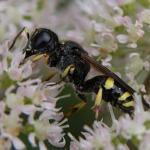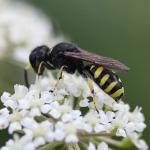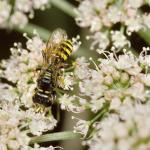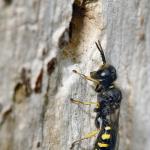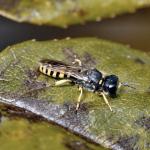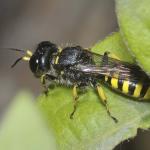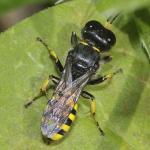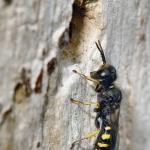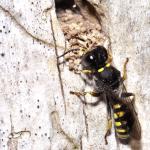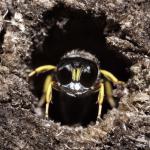Crabro chrysostomus (LEPELETIER & BRULLÉ,1835); Crabro cinctus (SPINOLA,1806); Crabro comptus (LEPELETIER & BRULLÉ,1835); Crabro denticulatus (PACKARD,1866); Crabro effosus (PACKARD,1866); Crabro gracilissimus (PACKARD,1866); Crabro interstinctus (SMITH,1856); Crabro obscures (SMITH,1856); Crabro papagorum (VIERECK,1908); Crabro xylurgus (SHUCKARD,1837)
A medium-sized Ectemnius with well-separated spots on the terga. Previously known as E. chrysostomus (Lepeletier & Brullé, 1835).
Our most widespread Ectemnius species with records throughout England and Wales, Scotland as far north as the Forres area (Moray), Ireland and Jersey. How ever, it is of rather local occurrence in many areas and there is strong evidence of a decline over much of central and southern England. This is particularly marked in counties such as Dorset, Hampshire, Hertfordshire and Warwickshire where recording levels have been relatively high in recent years. A Holarctic species, occurring from Europe to Japan in the Palaearctic region.
This species is not regarded as being scarce or threatened.
Recorded from a wide variety of habitats, including rides and clearings in woodland, wetlands, open countryside, coastal habitats and urban locations (though seemingly less frequent in the last habitat than some other Ectemnius species).
Probably double-brooded in some areas (Hamm & Richards, 1926; G R. Else, pers. comm.). Records are from early May to mid September, with a peak from late July to late August. Males usually emerge about a fortnight before the females.
Medium-sized flies such as syrphids, muscids, calliphorids, empids and smaller stratiomyids (Hamm & Richards, 1926; Lomholdt, 1975-76).
Nests are in decaying wood: old trees, stumps, fence posts, and even quite small pieces. The anterior section of the main burrow is very characteristically enlarged to about twice the diameter of the rest of the burrow. The remaining part of the nest consists of one or several burrows, from which the larval chambers are constructed as very short lateral branches (Lomholdt, 1975-76).
Mainly umbellifers such as angelica, hedge-parsleys, hogweed, rough chervil and water-dropworts; also goldenrods and spurges.
The anthomyiid fly Eustalomyia hilaris, the sarcophagid flies Amobia signatus and Macronychia polyodon and the pteromalid wasp, Pteromalus attack E. lapidarius (Hamm & Richards, 1926).
1998


